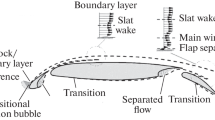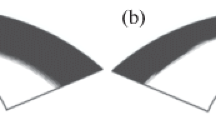Abstract
On the basis of high-order schemes, the viscous gas flow over the NACA2212 airfoil is numerically simulated at a free-stream Mach number of 0.3 and Reynolds numbers ranging from 103 to 107. Flow regimes sequentially varying due to variations in the free-stream viscosity are considered. Vortex structures developing on the airfoil surface are investigated, and a physical interpretation of this phenomenon is given.
Similar content being viewed by others
References
O. Mardsen, C. Bogey, and C. Bailly, “High-order curvilinear simulations of flows around non-Cartesian bodies,” J. Comput. Acoust. 13 (4), 731–748 (2005).
C. K. W. Tam and H. Ju, “Numerical simulation of the generation of airfoil tones at a moderate Reynolds number,” AIAA Paper, No. 2006-2502 (2006).
R. D. Sandberg, L. E. Jones, N. D. Sandham, and P. F. Joseph, “Direct numerical simulations of noise generated by airfoil trailing edges,” AIAA Paper, No. 2007-3469 (2007).
L. E. Jones and R. D. Sandberg, “Direct numerical simulations of noise generated by the flow over an airfoil with trailing edge serrations,” AIAA Paper, No. 2009-3195 (2009).
M. Riherd, S. Roy, D. Rizzetta, and M. Visbal, “Study of transient and unsteady effects of plasma actuation in transitional flow over an SD7003 airfoil,” AIAA Paper, No. 2011-1075 (2011).
I. Mary and P. Sagaut, “Large eddy simulation of flow around an airfoil,” AIAA Paper, No. 2001-2559 (2001).
E. Manoha, C. Herrero, P. Sagaut, and S. Redonnet, “Numerical prediction of airfoil aerodynamic noise,” AIAA Paper, No. 2002-2573 (2002).
P. E. Morgan and M. R. Visbal, “Large-eddy simulation of airfoil flows,” AIAA Paper, No. 2003-777 (2003).
S. R. Koh, K. W. Chang, and Y. J. Moon, “Turbulence trailing-edge noise at low Mach number,” AIAA Paper, No. 2005-2974 (2005).
A. A. Oberai, F. Roknaldin, and T. J. Hughes, “Computation of trailing-edge noise due to turbulent flow over an airfoil,” AIAA J. 40 (11), 2206–2216 (2002).
X. Gloerfelt and T. Garrec, “Trailing edge noise from an isolated airfoil at a high Reynolds number,” AIAA Paper, No. 2009-3201 (2009).
A. D. Savel’ev, “Multioperator representation of composite compact schemes,” Comput. Math. Math. Phys. 54 (10), 1522–1535 (2014).
O. Arias, O. Falcinelli, N. Fico, Jr., and S. Elaskar, “Finite volume simulation of a flow over a NACA0012 using Jameson, MacCormack, Shu, and TVD Esquemes,” Mec. Comput. 26, 3097–3116 (2007).
F. R. Menter, “Zonal two equation k-ω turbulence models for aerodynamic flows,” AIAA Paper, No. 93-2906 (1993).
L. G. Loitsyanskii, Mechanics of Liquids and Gases (Nauka, Moscow, 1987; Begell House, New York, 1996).
T. J. Coacley, “Turbulence modeling methods for compressible Navier–Stokes equations,” AIPP Paper, No. 83-1693 (1983).
A. D. Savel’ev, “Practical comparison of two turbulent models,” Mat. Model. 21 (9), 108–120 (2009).
A. D. Savel’ev, “Numerical simulation of acoustic radiation of a two-dimensional cavity in subsonic flow,” Uch. Zap. TsAGI 45 (1), 57–74 (2014).
J. L. Steger, “Implicit finite-difference simulation of flow about arbitrary two-dimensional geometries,” AIAA J. 16, 676–685 (1978).
R. B. Langtry and F. R. Menter, “Correlation-based transition modeling for unstructured parallelized computational fluid dynamics codes,” AIAA J. 47 (12), 2894–2906 (2009).
V. V. Vlasenko and A. N. Morozov, “Algorithm for triggering laminar-turbulent transition in the numerical flow simulation based on the Reynolds equations,” Uch. Zap. TsAGI 42 (4), 49–63 (2011).
V. V. Vozhdaev, A. F. Kiselev, D. S. Sboev, L. L. Teperin, and S. L. Chernyshev, “Simulation of the laminarturbulent transition on the basis of the numerical solution of the nonstationary Navier–Stokes equations,” Uch. Zap. TsAGI 47 (3), 38–46 (2016).
J. Erdos and A. Pallone, “Shock-boundary layer interaction and flow separation,” in Proceedings of Heat Transfer and Fluid Mechanics Institute (Stanford Univ. Press, Stanford, CA, 1962), pp. 239–254.
G. N. Abramovich, Applied Gas Dynamics, 5th ed. (Nauka, Moscow, 1991), Part 1 [in Russian].
G. M. Bam-Zelikovich, “Computation of boundary layer separation,” Izv. Akad. Nauk SSSR, Otd. Tekh. Nauk, No. 12, 68–85 (1954).
L. V. Gogish and G. Yu. Stepanov, Turbulent Separated Flows (Nauka, Moscow, 1979) [in Russian].
Author information
Authors and Affiliations
Corresponding author
Additional information
Dedicated to the 100th birthday of Academician N.N. Moiseev
Original Russian Text © A.D. Savel’ev, 2018, published in Zhurnal Vychislitel’noi Matematiki i Matematicheskoi Fiziki, 2018, Vol. 58, No. 2, pp. 291–303.
Rights and permissions
About this article
Cite this article
Savel’ev, A.D. High-Order Multioperator Compact Schemes for Numerical Simulation of Unsteady Subsonic Airfoil Flow. Comput. Math. and Math. Phys. 58, 274–285 (2018). https://doi.org/10.1134/S0965542518020148
Received:
Published:
Issue Date:
DOI: https://doi.org/10.1134/S0965542518020148




